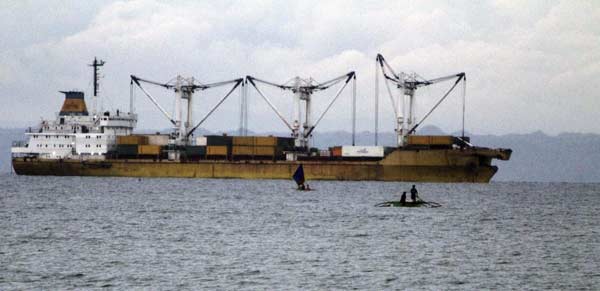Ferry sinks in Philippines killing 28, over 200 missing
|
 |
|
A cargo vessel docked at a sea is pictured after colliding with passenger ferry St Thomas of Aquinas, in Talisay, Cebu, central Philippines August 17, 2013. [Photo/Agencies] |
CEBU, Philippines - A ferry sank in the central Philippines on Friday killing at least 28 people after colliding with a cargo vessel owned by a company involved in the world's worst peacetime maritime disaster nearly 30 years ago.
More than 200 people were still missing after the collision just outside the port of Cebu that left two huge holes in the bow of the cargo ship.
Small planes and helicopters were scouring the waters for survivors and divers were to seach the sunken vessel later in the day after an oil slick had cleared, officials said.
Some 630 people had been rescued, many by fishing boats, and 214 were missing, the coast guard said. Many of the survivors were sick from swallowing oil and seawater.
The 40-year-old ferry was approaching Cebu when it collided with the departing cargo ship, the Sulpicio Express 7, at about 9 pm (1300 GMT). It sank in minutes.
"Search and rescue operations by the navy and coast guard are continuing with the help of some commercial vessels," acting coast guard chief Rear Admiral Luis Tuason told local radio.
"The number of missing is still huge."
The Sulpicio Express 7 is owned by unlisted firm Philippine Span Asia Carrier Corp, formerly known as Sulpicio Lines Inc, which owned the MV Dona Paz ferry.
That vessel collided with a tanker in the Sibuyan Sea in December 1987, killing 4,375 on the ferry and 11 of the tanker's 13-man crew.
Scores, sometimes hundreds, of people die each year in ferry accidents in the Philippines, an archipelago of 7,100 islands with a notoriously poor record for maritime safety.
Overcrowding is common, and many of the vessels are in bad condition.
The owners of the ferry involved in Friday's accident said it was carrying 723 passengers, 118 crew and 104 20-ft containers. It had an authorized capacity of 1,010 passengers and crew and 160 containers.
The ferry had requested a change in its approach to port minutes before the accident, Tuason said, but it was unclear if the cargo vessel had agreed.
The captains of the two ships were alive but had yet to be questioned, Tuason said.
The ferry sank about a kilometre off Cebu.
"We felt the cargo ship hit us and minutes later we noticed our ship was listing," passenger Aldrin Raman told reporters. "I grabbed a life vest and jumped overboard. I saw many passengers doing the same."
One of the crew said the ferry sank within 10 minutes of the collision.
"The collision left a gaping hole in the ferry and water started rushing in, so the captain ordered (us to) abandon ship," the crew member said. Most of the passengers were already wearing life jackets before the ship sank, he added.
Another passenger, Jerwin Agudong, said several people had been trapped. "It seems some were not able to get out. We saw dead bodies on the side," he said.
Fishermen on shore said they saw flares.
"It was very dark and we could hear a lot of people shouting, asking for help," said George Palmero, a 35-year-old fisherman who helped pull 10 survivors from the water.





















